Posts Tagged ‘porcelain’
Sunday, August 30th, 2015
This globular form porcelain teapot was made in China in the mid-1700s for export to Europe and North America. It measures 6 inches high and 9 inches from handle to spout and is decorated in the famille rose palette with a coral scale ground and puce flowers.
Soon after the teapot dropped and the handle shattered, it was taken to a tinker, jeweler or metalsmith who fashioned this nicely made metal replacement handle. To help insulate delicate hands from the hot contents, the handle was encased in woven rattan. I have dozens of examples of woven rattan handles and have noticed distinctly different patterns among them. I am hoping to one day match up the woven handle patterns to specific makers, although I know that is a long shot. As an added bonus, a small section of missing rattan has been patched using string, no doubt at a later date, a true case of a make-do making-do.
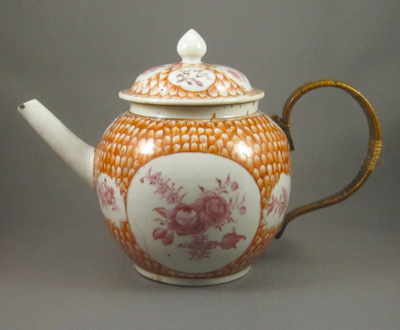
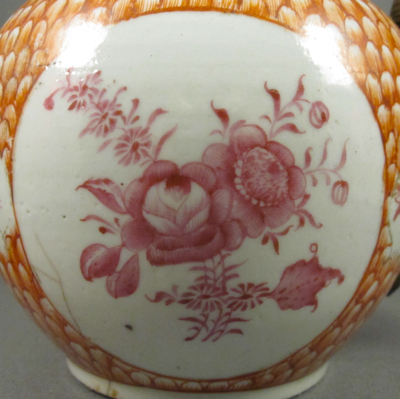
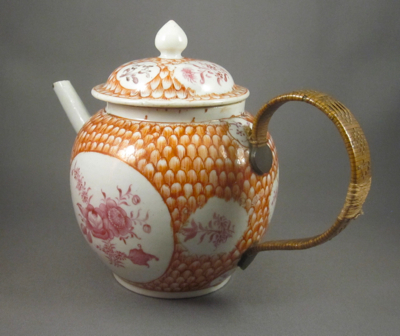
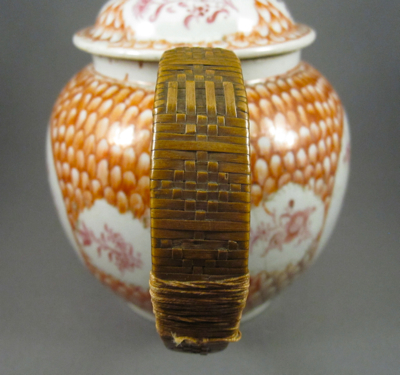
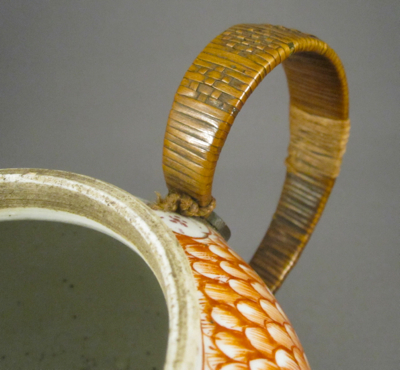
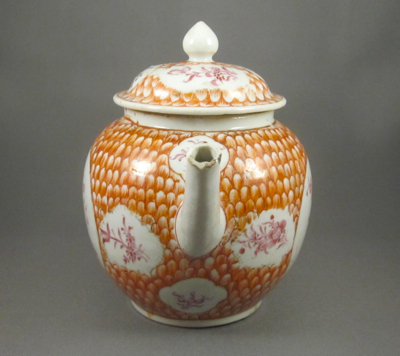
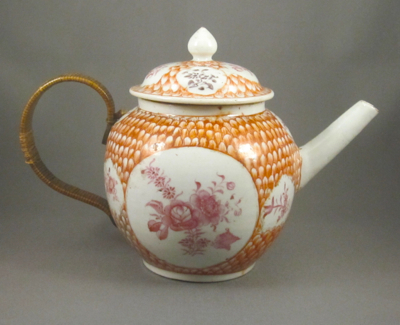
This teapot with similar form and decoration shows what the original loop handle on my teapot looked like before it took a tumble.
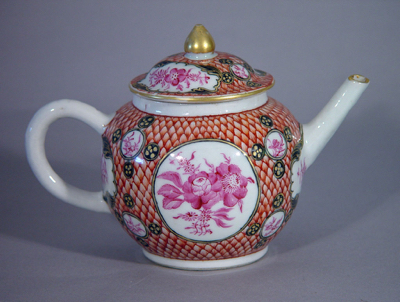
Photo courtesy of Earle Vandekar of Knightsbridge
Tags:Chinese, globular, metal handle, porcelain, rattan
Posted in teapot | No Comments »
Sunday, July 5th, 2015
This cup is a mess! It’s a 2.5 inch high Chinese porcelain cup from the Qianlong period (1736-1795) with multi-color enamel decoration in the Mandarin style. Well over 150 years ago when it dropped and shattered into 12 pieces, it was most likely taken to an itinerant “dish mender” who carefully applied 15 metal staples to bring it back to life. A bit of plaster was used to fill in a few gaps left by lost fragments. Past owners really must have cherished this little mug, as it managed to survive many centuries looking like this. As my grandmother would have said, “Oy Vey!”
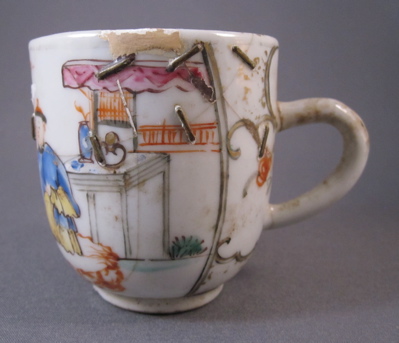
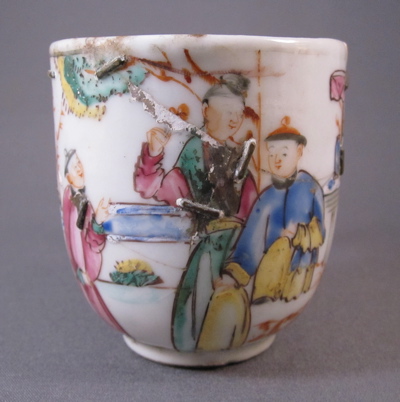
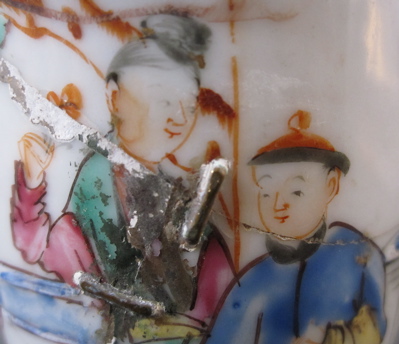
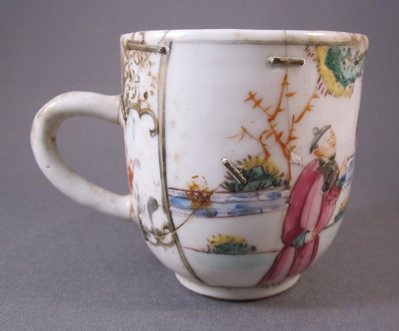

This cup, in much better condition than mine, shows what an intact example looks like.
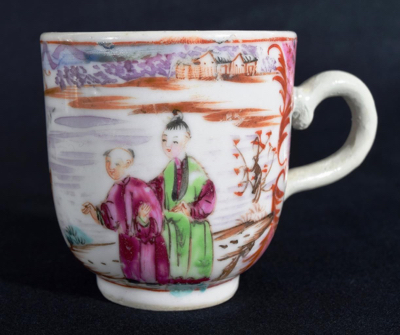
Photo courtesy of eBay
Tags:Chinese, Mandarin, porcelain, staples/rivets
Posted in cup/saucer | No Comments »
Saturday, June 20th, 2015
I spotted this during my last visit to the American Wing at The Metropolitan Museum of Art in New York City. The description in the showcase says more than I could possibly say:
“This extraordinary punchbowl features a remarkably faithful replica of the engraved certificate, dated December 1785, issued to Ebenezer Stevens (1751-1823) by the Society of the Cincinnati. Stevens was a major-general in command of the New York artillery and was vice president of the New York branch of the society. The decorative silver-gilt mount on the rim and around the foot were probably made during the early nineteenth century in response to an earlier crack—evidence of the extent to which the bowl was valued by its owner…”
Punch Bowl
Date: ca. 1786–90
Geography: China
Culture: Chinese, for American market
Medium: Porcelain
Dimensions: Diam. 16 in. (40.6 cm)
Classification: Ceramics
Credit Line: Gift of Lucille S. Pfeffer, 1984
Accession Number: 1984.449
On view in Gallery 704
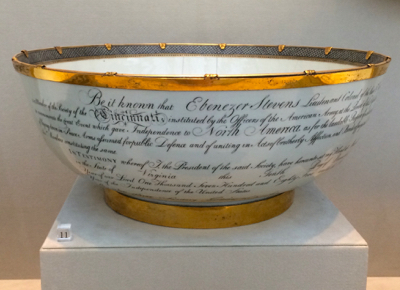

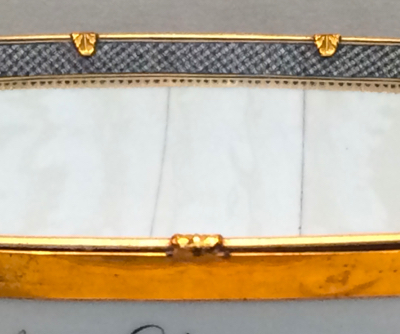
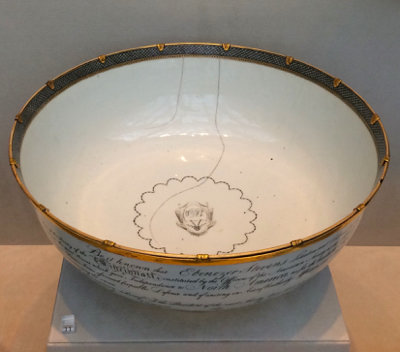
Tags:Chinese, commemorative, metal bands, porcelain, silver
Posted in anecdotal | No Comments »
Sunday, June 14th, 2015
I purchased this unmarked soft-paste teabowl from an antique ceramics dealer in the UK who appreciates early repairs and has provided me with many interesting examples of make-do repairs over the years. This piece was made by Philip Christian Liverpool Porcelain, c.1765-70, and measures 1-3/4 inches high x 3 inches diameter. It has a fluted body with molded leaves and flowers, a cobalt blue underglaze border of leaves and berries, and a flower motif painted on the inside.
This delicate teabowl boasts multiple repairs done by a 19th century “china mender.” After the bowl broke, a large chip was reattached using tightly bound brass wire wrapped around holes drilled through the body, appearing at first like more commonly used staple repairs. A large blob of lead was applied to the center of the crack, acting as an anchoring rivet. A smaller chip along the rim, perhaps lost or too small to repair, has been replaced with a thin sliver of porcelain decorated with iron-red scrollwork from another piece entirely. This type of repair, using thin wire instead of metal staples, is typically associated with 19th century repair work done in Belgium and the South of France.
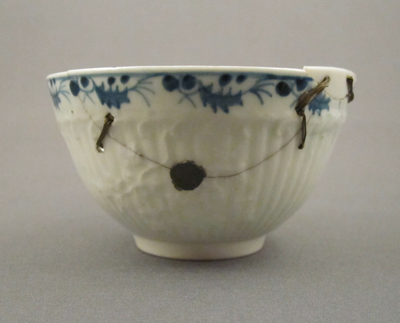
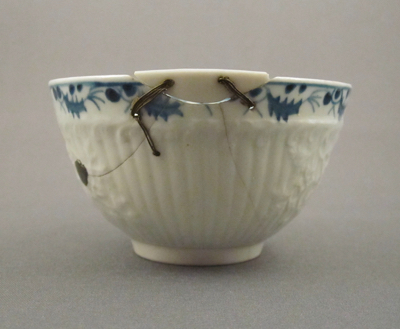
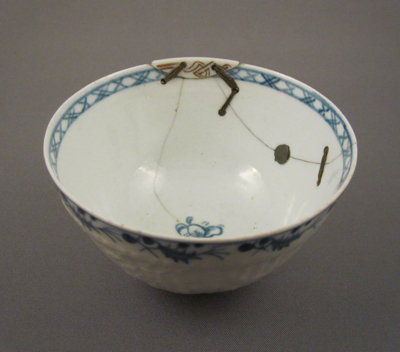
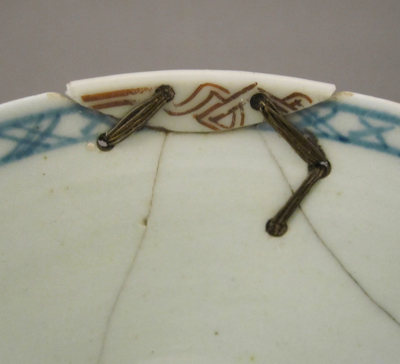
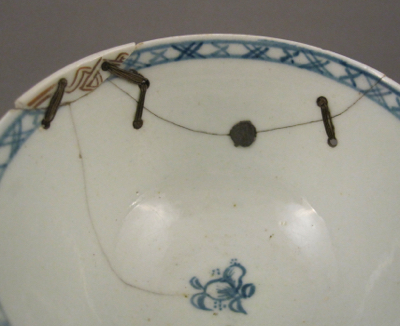
Below is a “perfect” example with matching saucer.
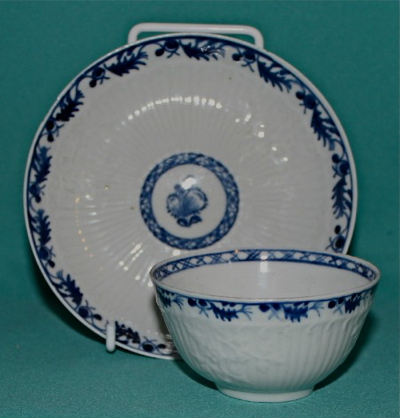
Photo courtesy of Antique Porcelain Online
Tags:blue & white, English, patch, porcelain, soft paste, wire
Posted in bowl/dish | 2 Comments »
Saturday, May 23rd, 2015
This thrice-repaired Chinese porcelain globular form teapot with Japanese influenced Imari decoration, is painted with a large chrysanthemum motif in underglaze blue, overglaze iron red and gilding, surrounded by stylized scrolling foliage. The bullet shape was inspired by European silver of the same period. It measures 4-1/2″ high and 7-1/2″ wide from handle to spout and dates to around 1720.
After the teapot was dropped over 200 years ago, resulting in a broken handle and spout, it was taken to a skilled silversmith who created this unusual silver zoomorphic replacement spout, added an engraved silver collar and used metal staples to repair the handle. In my opinion, the silver additions transform a perfectly nice teapot into a unique work of art.
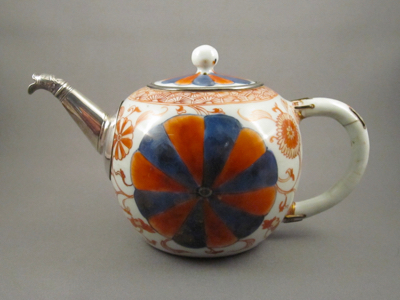
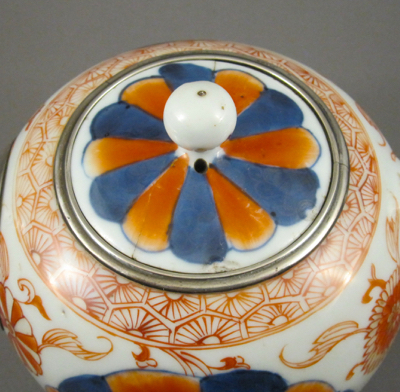
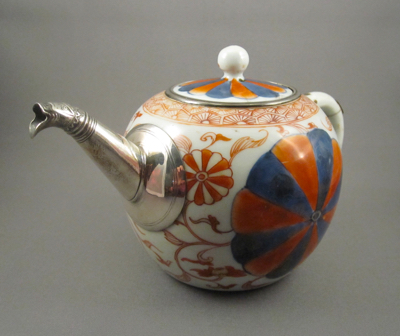

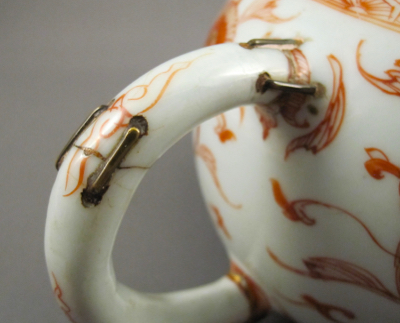
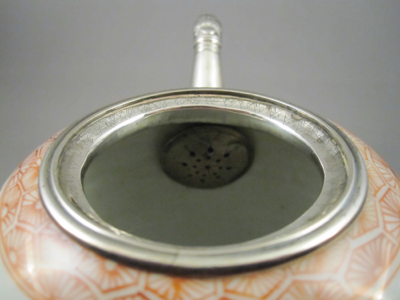
This nearly identical teapot shows what the original spout on mine looked like before it took a tumble.
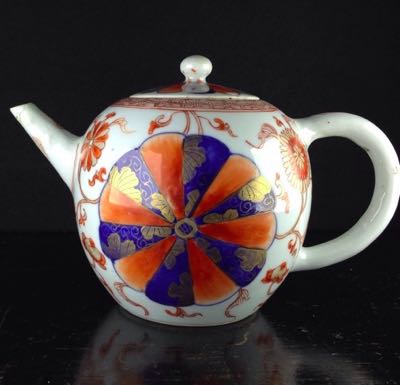
Photo courtesy of Moorabool Antiques
Tags:Chinese, porcelain, silver, staples/rivets
Posted in teapot | 3 Comments »
Wednesday, May 13th, 2015
This small Chinese porcelain “Kangxi revival” jar was made during the latter part of the Qing dynasty (1644-1912), Guangxu period (1875-1908). It is decorated in cobalt blue underglaze with eight figures and stands about 5″ high, with a four character mark on the underside.
At some point during its early life this jar was dropped, resulting in a complex fracture. But rather than tossing the broken pieces out on to the curb, they were taken to a china mender who lovingly restored the jar using metal staples, aka rivets. Judging by the form and the use of double rivets, the repair appears to have been done in the Middle East, where recycled wire was used by itinerant street menders to form flattened rivets.
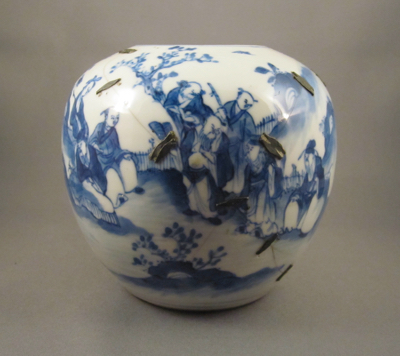
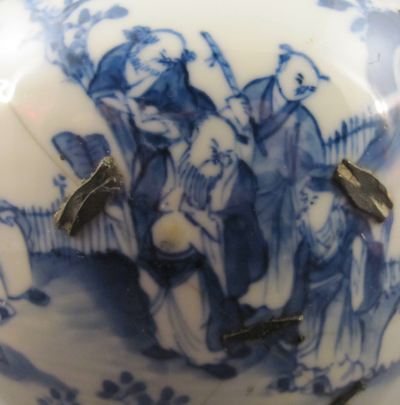


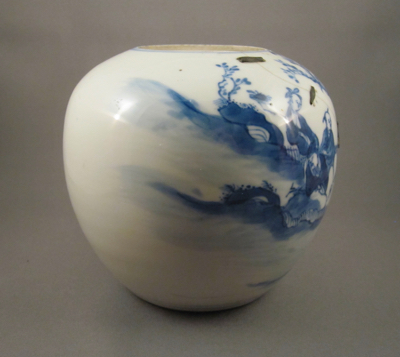
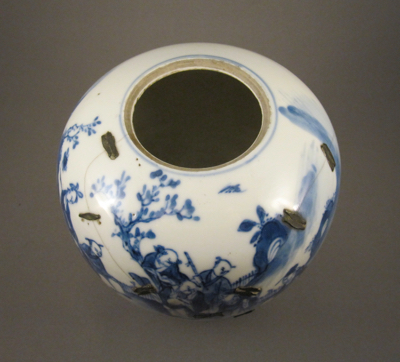
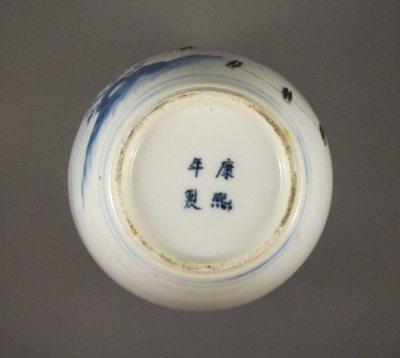
This jar has a similar form and decoration and remains in one piece.
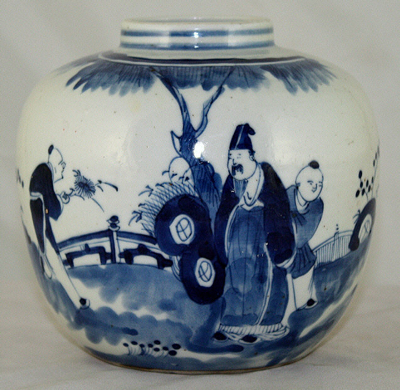
Photo courtesy of Petrie Rogers
Tags:blue & white, Chinese, porcelain, staples/rivets
Posted in pot/jar | 2 Comments »
Saturday, April 25th, 2015
I am back in London for a brief visit on my way to Ireland and the very first thing I did upon arrival was to head over to see the magnificent ceramics collection at the Victoria & Albert Museum. I could spend an entire day peering into the endless floor to ceiling glass cases filed with worldwide and world-class ceramics. Here are some of my favorite examples of inventive repairs found among the collection.
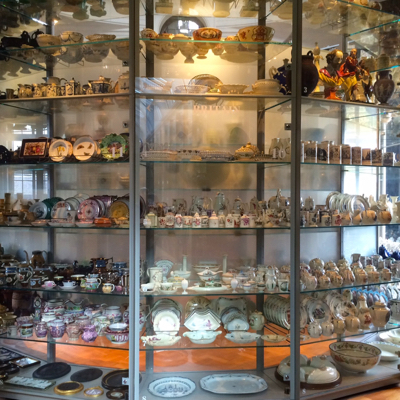
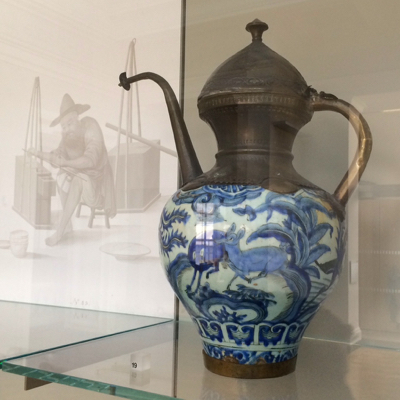
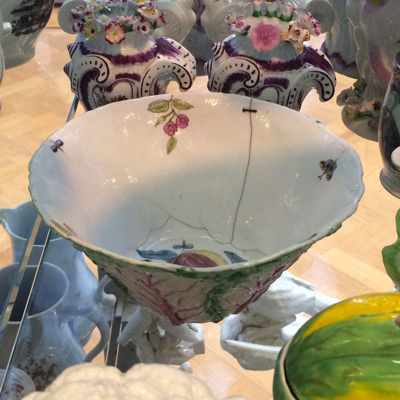
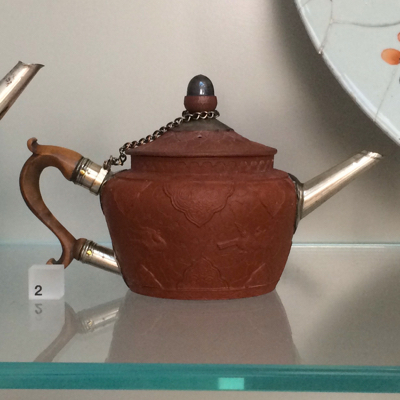
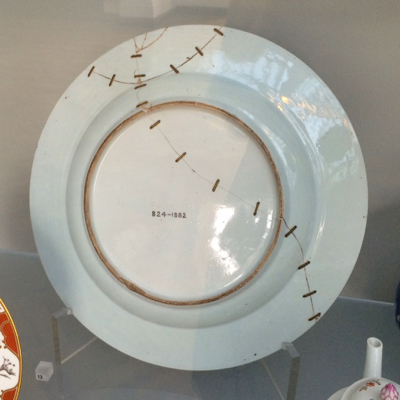


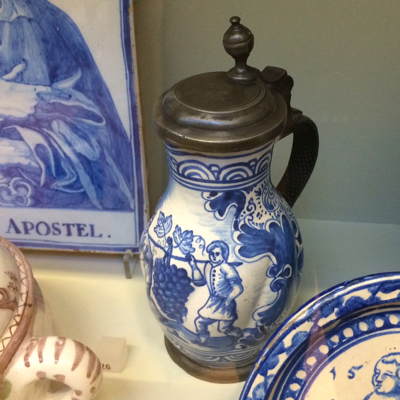
Take a look at this previous post from just over a year ago, showing other examples from the collection.
Tags:blue & white, brass, bronze, Chinese, metal handle, porcelain, pottery, silver, staples/rivets
Posted in anecdotal | No Comments »
Saturday, April 11th, 2015
Earlier this week I took a stroll through one of my favorite spots in Manhattan, The Henry R. Luce Center for the Study of American Art at The Metropolitan Museum of Art. If the Smithsonian Museum is known as “The Nation’s Attic”, then I’d like to christen the Luce Center “The City’s Yard Sale” as it is packed from floor to ceiling with glass showcases filled with over 18,000 tchotchkes, including Tiffany lamps, Shaker boxes and Revere silver. This impressive collection of the museum’s overflow allows the public to research and take a peek into the MET’s closets. If you look closely among the rare Chinese porcelain and early English pottery you will find dozens of pieces in various states of disrepair including visible cracks, chips, worn paint and missing parts.
Here are some of my favorite make-do’s, all hoping to one day escape the confines of the study center’s curio cabinets and be placed alongside their more presentable friends in the “big house.”
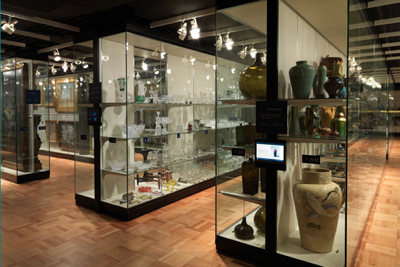



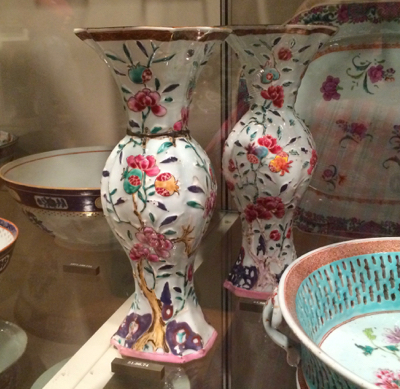
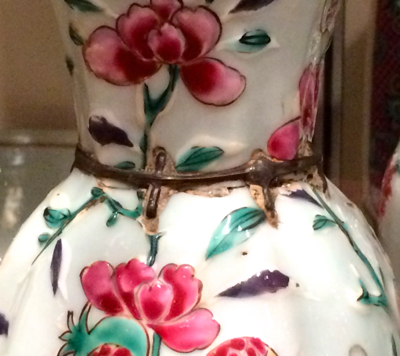


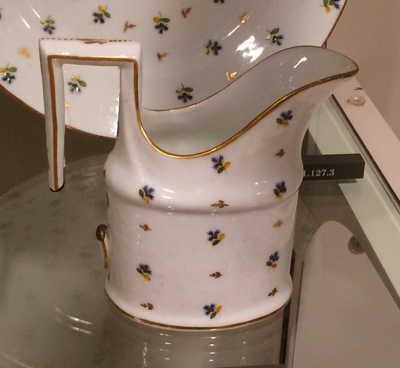


Tags:blue & white, bronze, Chinese, English, glass, metal base, metal handle, porcelain, pottery, staples/rivets
Posted in anecdotal | 2 Comments »
Saturday, April 4th, 2015
I own a classic book about collecting antique English household pottery, “If these Pots Could Talk” by Ivor Noel Hume. Regarding the early usage of this particular pot, I’d rather not hear what it has to say. This Chinese export porcelain chamber pot with cover dates from the Qianlong period (1735-1796) and measures 5-1/2″ high to the top of the lid and is 9-1/2″ wide to the end of the handle. It is hand decorated in the Famille Rose palette with panels of birds and flowers with gilt highlights.
The thought of about how this pot lost its original handle is something I’d rather not dwell on but I just hope it was empty when it broke. As this was an expensive and necessary asset to the household, it was not thrown out but immediately repaired and put back in to use. Most likely it was taken to a china mender who made a sturdy metal replacement handle, then covered it in woven wicker to aid against further slippage.
I remember a certain customer in my parents antiques shop years ago who purchased a large Victorian ceramic slop bucket from a bedroom chamber set. Knowing what it was, she proceeded to boast that she intended to use it as a soup tureen at an upcoming dinner party she was throwing for the kids where she had already talked to the http://www.jumpersjungle.com/santa-fe-springs/, team from kids birthday parties Santa Fe Springs to help her. If that pot could talk, I hope it would have warned the dinner guests not to eat the chowder!

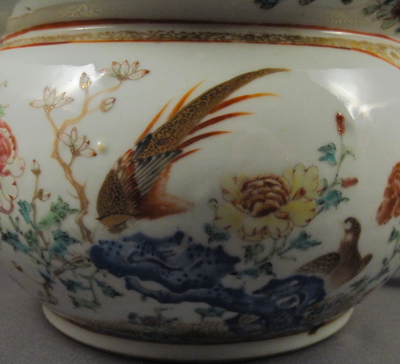
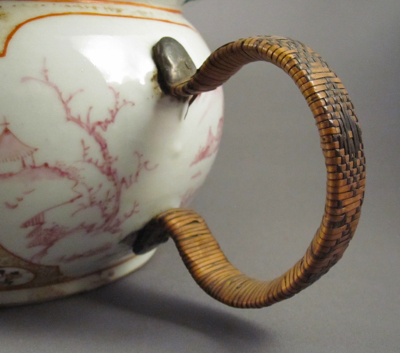


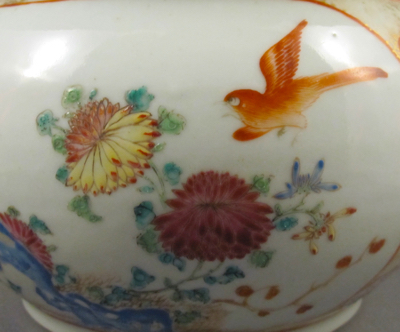
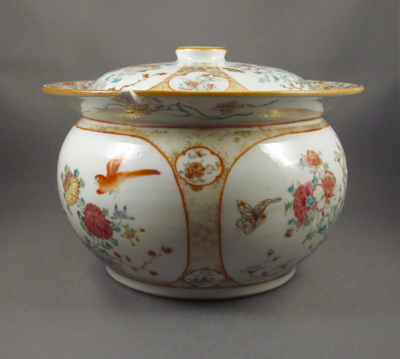

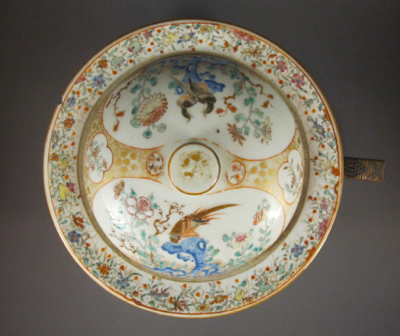
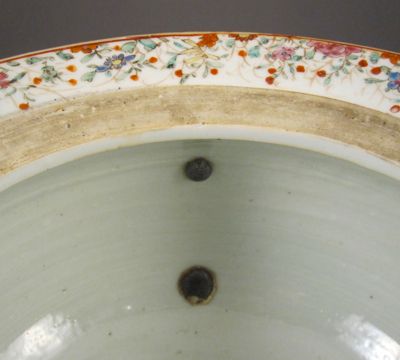
This identical example shows what the original handle on mine looked like before it broke off. Notice the multiple chips along the rim. I’m guessing that many chamber pots went bump in the night.
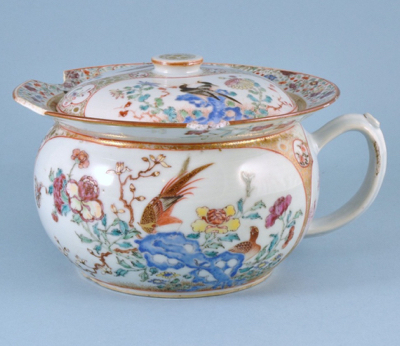
Photo courtesy of Andrew Dando
Tags:Chinese, metal handle, porcelain, Qianlong, rattan
Posted in pot/jar | 2 Comments »
Saturday, March 21st, 2015
This globular form teapot with hand painted floral decoration in cobalt blue and polychrome enamels was made in China for export to the European market in the mid to late 1700s. It measures 5-3/4″ high and 8-1/2″ wide from handle to spout.
After the teapot was dropped it was taken to a china mender who added an unusual crimped edge pewter sleeve at the base of the spout. Additionally, a hinge was added to attach the lid to the pot. I have many examples in my collection with metal chains added to keep teapots and lids together, but this is the first time I have seen an elaborate hinge of this sort.
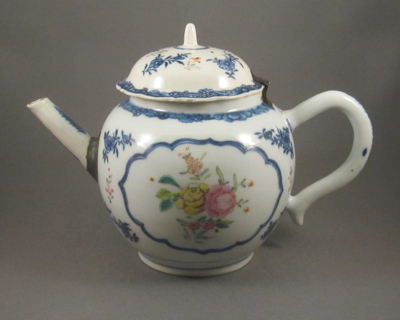
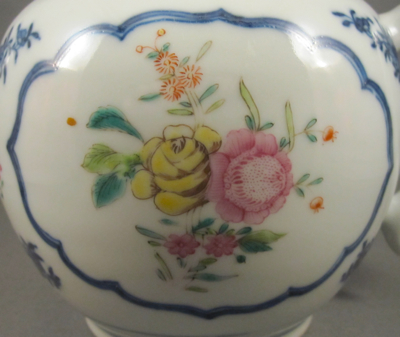
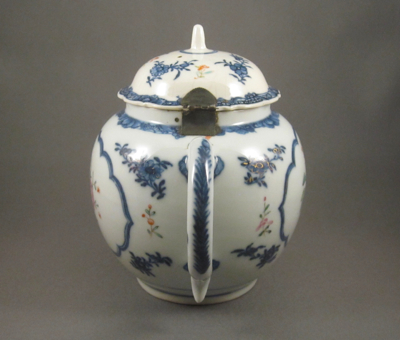
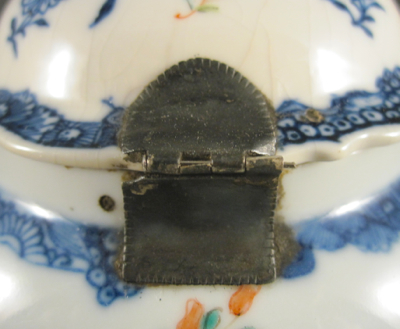
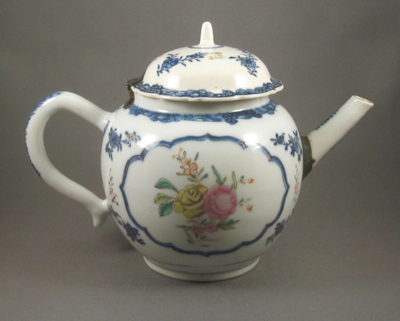
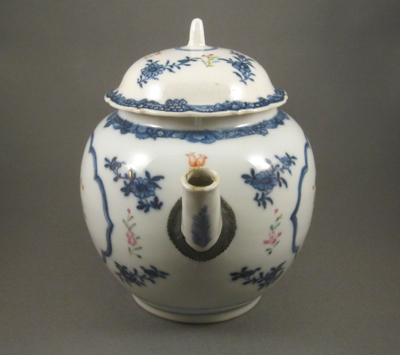
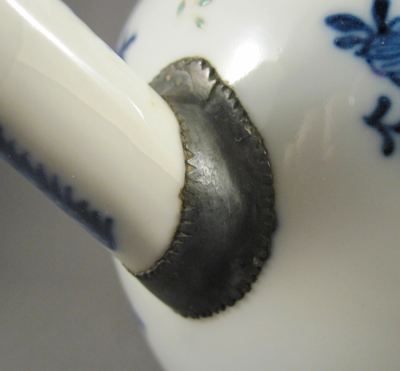
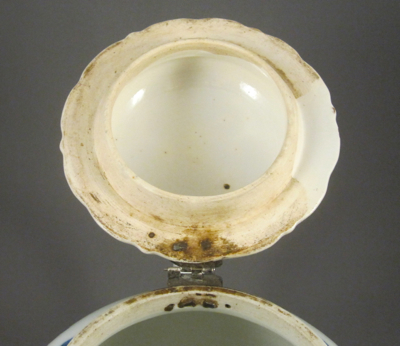
Tags:Chinese, globular, pewter, porcelain
Posted in teapot | No Comments »












































































